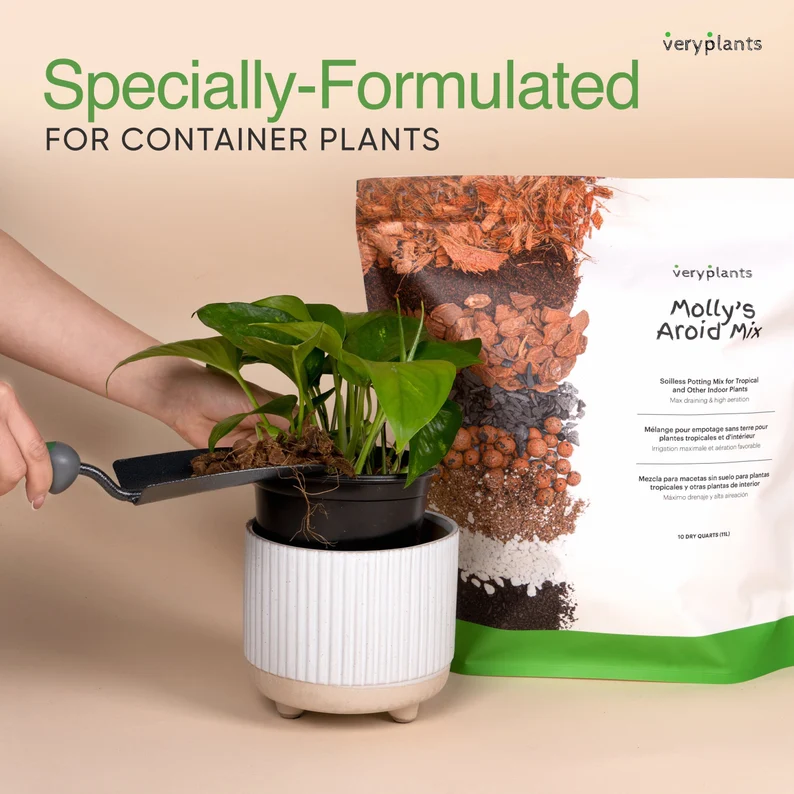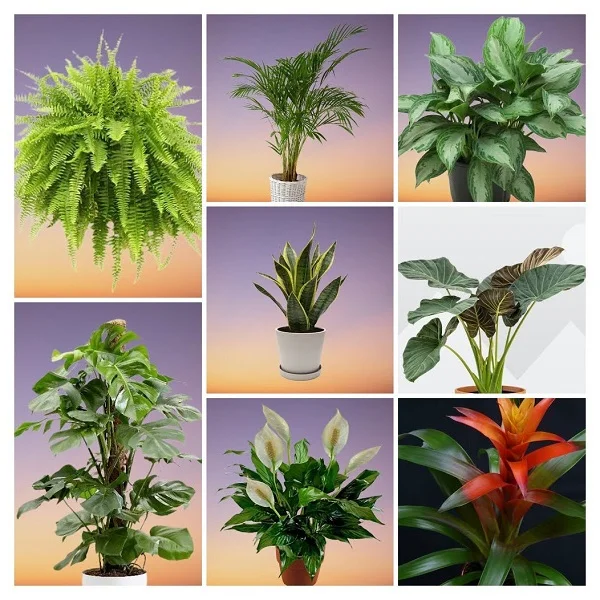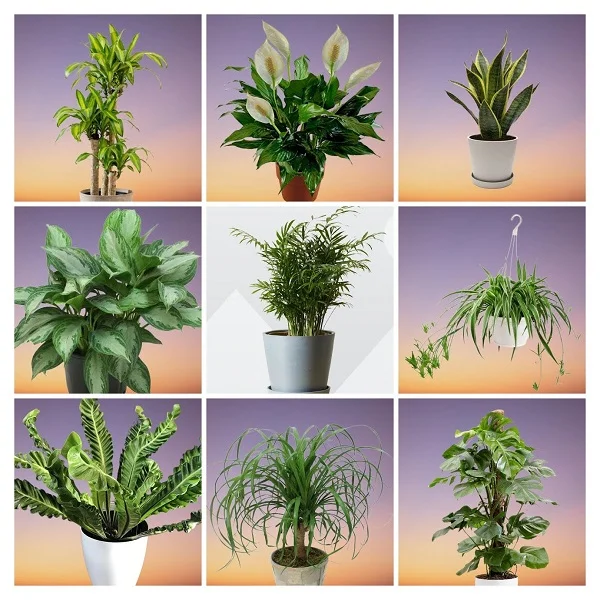Alocasia cuprea Care Indoors, Propagation, Problems and their Solutions
Some links in this post may be affiliate links
Alocasia cuprea flourishes in bright indirect light, warm and humid conditions and consistently moist, rich, well-drained soil coupled with fortnightly feeding in the growing season.
Alocasia cuprea is one of the compact Alocasia varieties which bears enormous, spherical, green leaves with a metallic gloss, pronounced leaf veins and deep-purple undersides.
The species name, 'cuprea', is in reference to the unusual coppery appearance of the leaves which is especially pronounced in young leaves.
On account of its compact size, magnificent foliage and affinity for highly warm and humid conditions, Alocasia cuprea is among the best plants for the bathroom.
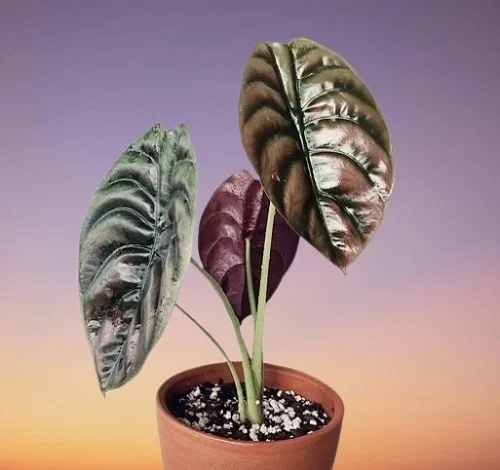
Botanical name: Alocasia cuprea
Family: Araceae
Origin
Alocasia cuprea has its orgins in the warm humid tropical areas of South East Asia to South America.
Size
Alocasia cuprea is a slow growing plant which grows to a height of 1 ft in about 2 years. The leaves are enormous and can grow to 1 ft long.
Flower
The flowers in Alocasia cuprea are unimpressive pale-colored spathes which only last a few days. To conserve the plants energy and direct it to foliage growth, cut the flowers as soon as they appear though it is unlikely to flower when grown indoors.
Varieties
One common variety is Alocasia cuprea 'Red Secret' whose leaves are red with dark almost black markings.
Is Alocasia cuprea toxic to pets?
Alocasia cuprea like other Alocasia Plants is toxic to both humans and pets as outlined by ASPCA. It contains crystals of calcium oxalate which if ingested can numb and swell the tongue and pharynx leading to difficulty in breathing and sharp pain in the throat. Keep Alocasia cuprea away from the reach of children, cats, dogs, and other pets to avoid any mishaps.
Where to Buy
If you would like to add Alocasia cuprea to your collection, you may acquire them online from Etsy (Link to Etsy) or from Amazon (Link to Amazon).
Alocasia cuprea Care Indoors
To care for Alocasia cuprea indoors, provide bright indirect light, average warmth of 18-260C, humidity of 70-80% and consistently moist, rich, well-drained soil coupled with fortnightly feeding during the growing season.
Alocasia cuprea care requires pruning to keep it neat and also discourage pest and disease infestations. Repotting is only needed when the roots grow through the drainage holes. Keep reading for more on these growing conditions and how to achieve them.
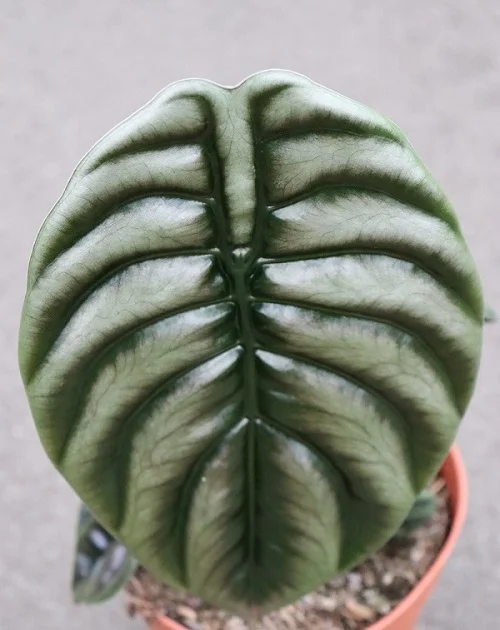
Watering
How often should I water my Alocasia cuprea?
Do not water Alocasia cuprea on a schedule to avoid overwatering or underwatering both of which are detrimental to the growth of the plant.
Water your Alocasia cuprea thoroughly in spring and summer while allowing the top 1-2 inches of soil to dry out slightly between waterings. Maintain the soil consistently moist but not soggy to avoid yellowing leaves.
Decrease watering in fall and winter to keep the soil barely moist but never allow the soil to dry out completely. Underwatering will signal dormancy which may cause the leaves to start dying in readiness for dormancy.
Alocasia cuprea does not like to sit in soggy soil as it is prone to fungal infestations like root-rot and leaf spot diseases. Therefore, make sure that the pot has a drainage hole to prevent the soil from getting soggy.
Light Requirements
How much light does Alocasia cuprea need?
Alocasia cuprea grows best under bright indirect light (filtered light). Keep it away from direct sunlight as it can cause the colorful leaves to fade (dull) and die.
Too little light will signal dormancy which may cause the leaves to start dying in readiness for dormancy. If the natural lighting is not adequate, you may use grow lights to supplement it.
Rotate the pot regularly to ensure that the plant gets light on all sides for even growth to prevent lop-sided growth.
Temperature and Humidity
Average warmth of 18-260C is ideal for Alocasia cuprea. Below 150C, the plant may drop all its leaves and go into dormancy. Keep it away from frost and drafts as they can cause leaf drop and death of the plant.
Alocasia cuprea requires high humidity of 70-80% to thrive. To raise humidity, set the pot on a wet pebble tray or use a cool mist humidifier.
You may also grow the plant in a well-lit bathrom, kitchen, laundry area and other moist areas in the home. Make sure that there is good air circulation to prevent fungal diseases.
Potting Mix
The best potting soil for Alocasia cuprea should be well-draining, moisture-retentive soil. A blend of 50% potting soil, 30% perlite, and 20% orchid bark is ideal for this plant.
Fertilizer
Feed your Alocasia cuprea with a liquid fertilizer (foliar feed) every 2-3 weeks in spring and summer for a lush growth.
Do not feed in fall and winter as the plant undergoes dormancy during this period and growth is minimal at this time.
Flush out accumulated salts arising from fertilizers every 2-3 months by running a stream of water through the soil until the water comes out through the drainage holes.
Repotting
Alocasia cuprea prefers to be root-bound, therefore, avoid frequent repotting as the plant can take upto 4-6 weeks to recover from repotting shock.
Repot into a 1 size larger pot during the growing season only if the roots have grown out through the drainage holes. Ensure that the pot has a drainage hole to prevent the soil from getting soggy as it can lead to fungal infestations. Take a look at these beautiful ceramic planters on Amazon.
Pruning & Grooming
Pruning Alocasia cuprea is easy. Remove yellow and diseased leaves as they occur to maintain your plant neat and to reduce chances of diseases and pests infestation.
Cut the leaves at the base with a sterilized knife or pair of scissors to avoid disease transimission. Take care not to injure the new leaves that are forming.
Regularly clean the leaves by damp wiping them with a soft cloth to get rid of dust and discourage pests infestation.
Propagation
Alocasia cuprea is propagated by plant division at the beginning of the growing season (spring) when the plant is actively growing.
Propagating Alocasia cuprea by plant division
- Water the plant thoroughly at least 1 day before to make it easier to divide and also hasten establishment.
- Carefully remove the plant from its pot and loosen the soil to expose the rhizome.
- Gently divide the rhizome into sections by cutting through with a sharp sterilized knife. Ensure that each section has 1-2 stems.
- Pot these sections in individual pots in moist free-draining soil at the same depth that they were in the previous pot.
- Ensure that the pot has a drainage hole to prevent the soil from getting soggy as it can lead to rotting.
- Place the set up in a warm, well-lit place away from direct sunlight.
- Maintain the soil moist until new growth emerges after which routine care can begin.

Alocasia cuprea Problems & Remedies
Alocasia cuprea problems are yellowing leaves, drooping leaves, brown leaves, dropping leaves and dying plant, brown leaf spots, fading leaf color, pests and diseases among others. Keep reading for more on these problems and how to fix them.
Yellowing leaves
Why are my Alocasia cuprea leaves turning yellow?
Some of the causes of yellow leaves on Alocasia cuprea are dry air, overwatering, soggy soil and aging.
How to fix it
Remove such leaves by snipping them off at the base with a clean sharp knife or a pair of scissors.
Dry air: Set the pot on a wet pebble tray, use a humidifier or grow the plant in a well-lit bathroom.
Overwatering: Water only when the top 1-2 inches of soil dry out.
Soggy soil: Use well-draining soil and a pot that has a drainage hole.
Aging: It is natural for the old leaves to turn yellow and drop as the plant matures.
Drooping leaves
Why is my Alocasia cuprea drooping?
Drooping leaves on your Alocasia cuprea are caused by underwatering, temperature stress, dry air, and spider mites infestation.
How to fix it
Underwatering: Water when the top 1-2 inches of soil dry out but do not allow the soil to dry out completely.
Temperature stress: Keep the plant away from drafts coming from AC units, heat sources and others to maintain temperatures of 15-280C.
Dry air: Set the pot on a wet pebble tray or use a humidifier to heighten humidity. Group the plants together to create a humid microclimate.
Spider mites infestation: Keep the plant well pruned. Increase humidity to discourage the pests.
Brown leaves
Why are the leaves on my Alocasia cuprea turning brown?
The main causes of brown leaves on your Alocasia cuprea are inconsistent watering, soggy soil, and extreme temperatures.
How to fix it
Inconsistent watering: Do not water on a schedule. Water when the top 1-2 inches dry out. Never allow the soil to dry out completely.
Soggy soil: Use a pot with a drainage hole and well-draining soil.
Extreme temperatures: Keep the plant away from drafts coming from AC units, drafty windows, heat sources, windy doors and others.
Dropping leaves and dying plant
Dropping leaves and dying plant in Alocasia cuprea is caused by too little light, cold temperatures and underwatering. These conditions signal dormancy hence the leaves die in readiness for dormancy.
How to fix it
Too little light: Move the plant to a brighter spot or instal a grow light if the natural light is not adequate.
Cold temperatures: Keep it away from cold drafts to maintain a warmth of 18-260C.
Underwatering: Water when the top 1-2 inches of soil dry but do not allow the soil to dry out completely.
Brown leaf edges
Brown leaf edges on Alocasia cuprea are caused by low humidity, underwatering and salts buildup.
How to fix it
Low humidity: To raise humidity, set the pot on a wet pebble tray or use a cool mist humidifier.
Underwatering: Water when the top 1-2 inches of soil feel dry but not leave the soilball to dry out completely.
Salts buidup: Flush out the accumulated salts from the soil every 2-3 months by running a stream of water through the soil until it drips through the drainage holes.
Fading leaf color
Fading leaf color on Alocasia cuprea is due to too little light. Position the plant in a brighter spot or instal a grow light if the natural light is not enough.
Pests
Common pests on Alocasia cuprea are mealybugs, spider mites, scales and aphids.
How to fix it
- Check underneath the leaves regularly for these pests and take timely control measures.
- Seperate the affected plant to prevent spread to other plants and treat it with neem oil or insecticidal soap as per the manufacturers' instructions.
- Regularly damp-wipe the leaves with a soft cloth to discourage the pests.
- Keep the plant well pruned to minimize the hiding and breeding places for these pests.
Diseases
Alocasia cuprea is prone to leaf spot disease which is enhanced by soggy soil and overwet conditions. The disease presents as dark brown or black leaf spots.
How to fix it
- Remove and burn the affected parts to reduce the risk of spread to the rest of the plants.
- Spray the affected plant with a systemic fungicide and ensure to cover all the parts with the fungicidal solution.
- Keep the plant on the dry side, do not mist it and ensure good air flow.
- Use a pot with a drainage hole and well-drained soil.
Conclusion
Alocasia cuprea is a stunning yet delicate plant that thrives in warm, humid conditions with bright, indirect light. Proper watering, humidity, and fertilization ensure healthy, shiny leaves and steady growth. By following these care tips, you can enjoy the beauty of this jewel-like plant indoors.
You liked it? Share on social media.
Related Content
Amazon Associates Disclosure
Homeplantsguide.com is a participant in the Amazon Services LLC Associates Program, an affiliate advertising program designed to provide a means for sites to earn advertising fees by advertising and linking to amazon.com.


